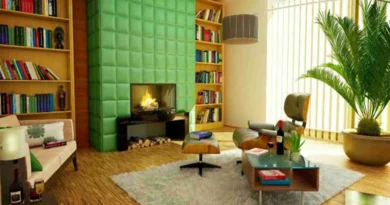Small Space Interior Upgrade: Transforming Tiny Spaces into Functional Masterpieces
In a time when urban living, high rent, and minimalist lifestyles are the norm, it is more important than ever to make the most of compact living spaces. Small-space interior solutions offer a creative and practical way to live more comfortably and elegantly, regardless of whether you live in a compact house, studio apartment, or just have rooms with limited space. By making such changes, you should reconsider your space so that it matches your life rather than the other way around. There is more to it than simply packing things into awkward spaces. Outlining Compact Area Interior Improvements Upgrades to interior spaces are deliberate, focused changes intended to improve the use, comfort, and aesthetics of small living spaces. Unlike big home improvements, these changes prioritize functionality and efficiency. By employing ingenious design strategies to create areas that feel airy, well-organized, and attractive, they seek to accomplish more with less. These adjustments can significantly enhance how a space is used and experienced, whether it’s turning a closet into a home office, swapping out a large sofa for a small sectional, or adding floating shelves to free up floor space.
Typical Features of Improvements in Compact Areas
Better Use of Every Square Foot
The most obvious and immediate benefit of tiny space upgrades is the increased usefulness of your home. When every inch counts, upgrades are made to ensure that every space serves a purpose and to eliminate dead space. Any area can be made more usable with the help of foldable tables, modular furniture, personalized storage solutions, and multipurpose pieces like mattresses with drawers or chairs with hidden storage.
By making five practical changes, you can
1. Create separate spaces for eating, working, and relaxing—even in the same room. 2. To make small kitchens or bathrooms more comfortable, use pull-out cabinets, over-the-toilet storage, and space-saving fixtures.
3. Use vertical space for storage, keeping floors clutter-free and open.
This optimization not only improves daily convenience but also adds value to how you interact with your home.
Better Comfort and Appearance
Even if you have limited square footage, you may still make major changes to your home’s appearance with little space upgrades. Mirrors, translucent curtains, a fresh coat of light paint, and well-placed lighting can all make a small space appear twice as large. More significantly, these decorative additions make your house more comfortable overall. A clean, well-lit, open area has a significant psychological impact. It provides the following benefits:
1. An air of openness that lessens any perception of congestion or restriction. 2. A happier and less stressed state of mind.
3. An environment that is more pleasant to family members and visitors.
Small changes like updating textiles, organizing open shelves attractively, or coordinating your color palette can have a surprisingly large emotional effect on your well-being.
An Economical Method to Enhance Quality of Life
Generally speaking, little space changes are less expensive and take less time than full-scale renovations. Installing floating shelves, switching out old lighting with LED strips, or buying a multipurpose couch are examples of repairs that don’t need permits, razing, or week of disturbance.
Among the advantages are:
1. Affordability: The majority of modifications may be completed on a small price by utilizing used materials, DIY projects, or flat-pack furniture.
2. Fast transformation: A weekend or even a single day might be used to finish a lot of projects.
3. Minimal disturbance: Your house is still habitable throughout the process because you aren’t renovating any significant infrastructure.
Because of this, interior modifications are a great choice for families, young professionals, renters, or learners who want to gradually enhance their living area.
Greater Order and Decreased Disorder
The capacity to manage your life is one of the most important and life-changing effects
of minor space improvements. Clutter may rapidly accumulate in a small home. Improved organization has the following advantages:
1. Less maintenance and cleaning.
2. A decrease in the weariness and strain associated with decision-making. 3. An awareness of efficiency and authority over daily tasks.
In addition to improving the area’s appearance, clearing clutter improves mental clarity and fosters a peaceful, productive environment.
Increased Property Marketability and Value
Upgrades to small spaces are strategic investments for homeowners, not just ways to improve their lifestyle. A well-designed, little home will almost always draw more attention than one that feels crowded and disorganized. Clean, contemporary, multipurpose interiors with efficient use of space appeal to both renters and buyers.
Important advantages of real estate include:
1. A greater appeal to minimalists, couples, and urban professionals.
2. More expensive listings for apartments or tiny houses with clever renovations. 3. Quicker processing times for renting or sales.
Even something as basic as adding customized closest the organizers or updating bathroom and the kitchen cabinetry can help your home stand out in a crowded market.
Sustainability of the Ecological System
The carbon impact of smaller living areas is often lower, and this benefit is increased when they are renovated with sustainability in mind. Reusing components, acquiring only what you really need, and using energy-efficient equipment are common strategies for enhancing small space. Here are some instances of long-term advantages:
1. Reduced energy consumption due to smaller appliances, better insulation, and LED lighting.
2. Lighter furniture and fewer ornamental elements mean reduced resource consumption. 3. The opportunity to restore and reuse current resources in an appropriate manner. Making these eco-friendly choices can not only help the environment but also save you money on future maintenance and energy costs.
Scalability and Personalization
Making every part of your space fit your demands is one of the little-known benefits of remodeling small rooms. Rather of using universally applicable furniture or design, compact spaces frequently inspire personalization.
1. A custom wall-mounted desk made to precisely fit a corner is one example. 2. Setting up wardrobe-appropriate closet systems.
3. Making use of furniture that can be moved to accommodate different uses or room configurations.
Homeowners and renters are empowered by this level of personalization to design a space that suits their lifestyle, be it entertainment, hobbies, family needs, or distant work.
Promotion of Purposeful Living
Lastly, improving a little area inspires you to live a more deliberate life. You’ll pay closer attention to what you put in your house, what you show off, and how you use each space. Compact living frequently fosters a minimalist mentality that encourages thoughtful design, careful consumption, and simplicity.
1. One possible outcome of this is an increased appreciation for the things and available space.
2. A decrease in impulsive purchases and needless accumulation.
3. A calmer, more concentrated home setting.
Many discover that improving and reducing a small area results in a more free, values-driven living rather than a sense of restriction.
Conclusion
Small-scale interior design improvements may seem insignificant, but they have a significants influence. They effectively blend cost, style , functionality, and personalization. Every change counts , whether it’s making things more comfortable and functional or making things less cluttered and environmentally harmful. The size of the area is ultimately less significant than how you use it. Carefully planned renovations may turn even the tiniest home into a sanctuary.




